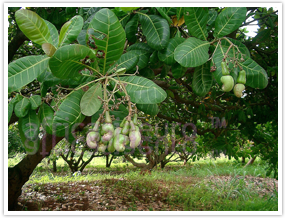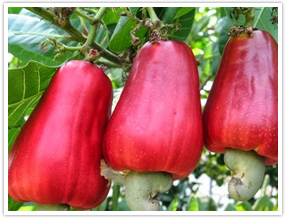| CALL US ON: +91 9900066400 FOR UPDATES AND LATEST NEWS |
|
|
Cashew nut
 Cashew (Anacardium occidentale), a native of Brazil, was introduced in India during the 16th Century. India has an area of about 8 lakh hectare under cashew, with an annual production of about 5 lakh tonnes of raw cashew nut. India is the largest producer, processor, consumer and exporter of cashew in the world. Cashew is a tropical plant. Temperature ranging from 20 to 30 degree Celsius, with an annual precipitation of 75 to 100 inches, is ideal for the cultivation of cashew. Cashew trees are generally planted with a spacing of 5 to 9 metres in square or equilateral triangular systems, depending on the slope and variety. The nymphs and tea mosquitoes sucking sap on tender leaves, shoots and inflorescence is the main problem in cashew cultivation.
Cashew (Anacardium occidentale), a native of Brazil, was introduced in India during the 16th Century. India has an area of about 8 lakh hectare under cashew, with an annual production of about 5 lakh tonnes of raw cashew nut. India is the largest producer, processor, consumer and exporter of cashew in the world. Cashew is a tropical plant. Temperature ranging from 20 to 30 degree Celsius, with an annual precipitation of 75 to 100 inches, is ideal for the cultivation of cashew. Cashew trees are generally planted with a spacing of 5 to 9 metres in square or equilateral triangular systems, depending on the slope and variety. The nymphs and tea mosquitoes sucking sap on tender leaves, shoots and inflorescence is the main problem in cashew cultivation.
 Plantations of unknown origin may yield about 1 to 2 kg per plant. Elite planting material coupled with improved agronomic practices will yield up to 8 to 10 kg per tree. Harvesting consists of reaping the nuts that have dropped to the ground after maturing, or before falling, along with cashew apples that are used to make jam, juice, syrup, fenni etc. Cleaning of cashew nuts is done manually, by sieving. The cleaned cashew nut is roasted in open pans or is made to go through the hot oil bath process for the extraction of cashew nut shell liquid (CNSL). The kernels are manually separated and the wholes are again classified into different grades of kernels and splits, based on certain physical characters. An estimated two million people are involved, directly or indirectly, in the cashew industry.
Plantations of unknown origin may yield about 1 to 2 kg per plant. Elite planting material coupled with improved agronomic practices will yield up to 8 to 10 kg per tree. Harvesting consists of reaping the nuts that have dropped to the ground after maturing, or before falling, along with cashew apples that are used to make jam, juice, syrup, fenni etc. Cleaning of cashew nuts is done manually, by sieving. The cleaned cashew nut is roasted in open pans or is made to go through the hot oil bath process for the extraction of cashew nut shell liquid (CNSL). The kernels are manually separated and the wholes are again classified into different grades of kernels and splits, based on certain physical characters. An estimated two million people are involved, directly or indirectly, in the cashew industry.

![]()
All rights reserved © | Privacy policy








